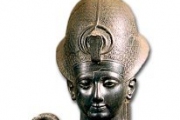Viewings: 8396

Discovered evidence of a conspiracy against the last major Egyptian Pharaoh's epoch of the New Kingdom of Ramses III. Egyptologists have uncovered the mystery of the death of the king, killed more than three thousand years ago. In the coup Rameses cut the throat with a sharp blade. However, the assassin of the Tsar do not escape retribution - buried him alive.
In ancient papyri says on suspicion of violent death of the ruler that fell at his wife and one of the sons of Pharaoh. The results of a study conducted by the Italian Institute for the study of mummies and the ice man at the European Academy in Bolzano (EURAC), published in the latest issue of the British medical journal BMJ.
The Pharaoh of the 20th dynasty, Ramses III, ascended the throne in the 26th day of the first month of a season shemu (25 February) 1187 BC and ruled until 1156 B.C. the reign of Ramesses III it is considered last significant period of rise of the Egyptian state in the era of the New Kingdom. Presumably he was over thirty, and in his family there were some children, when he became the Pharaoh. When Ramses started to build a huge memorial complex Medinet Habu on the West Bank of the Nile at Thebes. There were built two buildings in Carnac: the first one before the second pylon temple of Amon, the other close to the sacred lake of the temple of the goddess Mut, the mistress of the Isher.
In addition to grandiose construction, Ramses III led military campaign. On 5-th year of his reign in Egypt was invaded by Libyans. We are talking not about the enemy army, and about the whole Union Libyan tribes. After the victorious battle Egyptians cut off from their slain enemies 12 535 hand to bring them as war trophies Pharaoh. About this event clearly tells us one of the reliefs on the North side of the temple of Medinet-Abu. On the North side of the temple there are the episodes devoted to reflection invasion "peoples of the sea". Among them you can see not only the land, and sea battles. After a couple of years of battles with "peoples of the sea" the Egyptians again had to engage in battle with the Libyans.
About the family of Ramesses III has remained very little evidence. Once found a mention of the "great wife" Queen ISIS, the sister of the king. At Ramesses, presumably, was another wife ("second") - Queen Tella. The names of the other wives of Ramses III are missing, even "main" wife just mentioned only once. It is known that the Pharaoh had left behind a vast offspring: all his successors from Ramesses IV to Ramses IX were his sons and grandsons.
About a plot to assassinate Ramses III there are documents. This is the most famous Palace coup in the history of Ancient Egypt. According to ancient papyri, the conspirators headed by the Queen Tella and her son, Pentor. Rather, she wanted to sit on the throne of his child, bypassing the only legitimate heir of Ramesses IV. Just a failed coup involved more than 20 persons. After disclosure of sedition all participants lost their former names; this explains the strange title of Pentor, translated as "called another name". In Ancient Egypt, as in Ancient Rome, against the perpetrators acted custom Damnatio memoriae - "the curse of memory". To resolve the king, the conspirators resorted to magic and sorcery. From the texts we know that they were punished, but did not say if they managed to carry out his plan.
A study by computer tomograph has revealed on the neck of Pharaoh Ramesses great and deep incised wound that nearly reached the vertebrae. A sharp blade cut off the trachea and major blood vessels. It is unlikely that semicentenary the wound inflicted by the embalmers, says the head of the group of Italian scientists albert Zinc (Albert Zink). Egyptologists these precedents to deal have not accounted for. Inside wounds found attached, apparently, for embalming, the amulet Hawkeye Mountain - the symbol of Royal power and prosperous recovery after death. The bottom line is: the 14-th day of the third month of a season shemu on the 32nd year of the reign of Pharaoh Ramses III was killed.
Comparing DNA samples of bone tissue two mummies, scientists have come to conclusion, that the Pharaoh and 18-20-year-old boy was with each other relatives. However, the internal organs and the brain of a young man during mummification is extracted, which contradicts the ancient Egyptian funerary rites. Moreover, his body was wrapped in a ritually unclean unto the Egyptians sheep or goatskin. And there followed another discovery.
After new DNA analysis, researchers found that the mummy known as "Unnamed Prince" or Unknown Man E from the tomb at Deir El-Bahri (Deir el-Bahari), and patricide, Pentor is one and the same person. The famous French Egyptologist Gaston Maspero (Gaston Charles Camille Maspero) at the beginning of last century was expressed dramatic guess about the death of the young man: "Never face did not reflect such a painful and terrible agony. The distorted features of the unfortunate say that almost certainly he was buried alive".
















